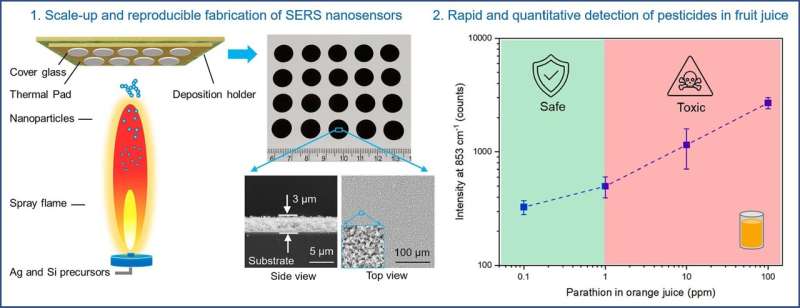This article has been reviewed according to Science X's editorial process and policies. Editors have highlighted the following attributes while ensuring the content's credibility:
fact-checked
trusted source
proofread
Inexpensive and efficient nanosensors can rapidly detect pesticides in fresh orange juice

Karolinska Institutet researchers Georgios Sotiriou and Haipeng Li at the Department of Microbiology, Tumor and Cell Biology have developed an inexpensive, fast, and reproducible nanosensor for food safety diagnostics. A new study in the Chemical Engineering Journal shows that the sensors can detect pesticides in fresh orange juice.
The study uses flame nanoparticle deposition to drastically lower manufacturing costs. These high-performance optical sensors can be fabricated at a laboratory production rate of 100 samples/hour, demonstrating the scalability and cost-effectiveness of the aerosol manufacturing strategy democratizing these sensors for practical applications.
"The abuse of pesticides in modern agriculture causes food safety and human health concerns, which are highlighted by the World Health Organization. As a result, to avoid any risks to human health, it is necessary to control the pesticide residue levels in food below safety limits.
"While SERS is powerful for fast and facile detection of pesticide residues in food products, its practical application is still restricted by the high expense, low scalability, and low reproducibility of the necessary sensors. To address this challenge, we explored here a low-cost, massive, and highly reproducible nanofabrication route for manufacturing SERS nano-plasmonic optical sensors," Georgios Sotiriou says.
"We used a process famous for its scalability and reproducibility, flame aerosol technology, to design and develop our robust nano-plasmonic optical sensors. We studied the surface uniformity, limit of detection, long-term stability, spot-to-spot reproducibility, sample-to-sample reproducibility, and batch-to-batch reproducibility of the fabricated SERS sensors.
"In addition, we benchmarked the performance of our SERS sensors against several state-of-the-art commercially available products and demonstrated their feasibility in a realistic and practical application by detecting pesticide residues in fruit juices," says Haipeng Li.
The team is now planning to increase the scalability of the fabrication process, aiming to offer affordable sensors for the market.
"We will also expand the application of our nano-sensors from detecting single pesticides to the mixed pesticides, i.e., to detect the 'cocktail effect of pesticides' (a combination of multiple chemicals may become more toxic) that are urgent for food safety in the EU. We are open to worldwide collaborations, which will speed up the integration of scientific work from the laboratory to society," Georgios Sotiriou says.
More information: Haipeng Li et al, Democratizing robust SERS nano-sensors for food safety diagnostics, Chemical Engineering Journal (2023). DOI: 10.1016/j.cej.2023.144023
Provided by Karolinska Institutet





















